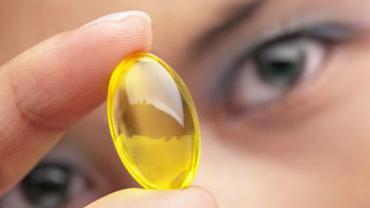
By now the health benefits of consuming seafood and other animal foods high in long-chain omega-3 fatty acids have become firmly ensconced in the medical literature. From ameliorating inflammation to supporting cognitive function eicosapentaenoic acid (EPA) and docosahexaenoic acid (DHA) support health through their own mechanisms as well as through serving to balance cytokines produced primarily from omega-6 fatty acids.
The benefits of fish oil supplementation on cardiovascular health are well established. Animal studies suggest fish oil may be helpful for maintaining skin hydration and the integrity of the skin barrier which may benefit individuals with chronically dry skin and atopic dermatitis. Another area in which fish oil might exert a positive effect is eye health.
Nutrients typically associated with good vision and overall ocular health include vitamin A carotenoids (such as lutein and zeaxanthin) and sulfur-containing compounds found in cruciferous vegetables. A substantial body of research indicates that the fatty acids found most abundantly in fish oil can appropriately be added to this list. One mechanism by which fish oil might boost eye health is reducing inflammation. We know that inflammation is at the center of so many health issues and in eye health it may interfere with the normal production of tears and eye lubrication both in quantity and chemical composition.
Dry eye syndrome or “dry eyes” has been the unfortunate victim of somewhat comical ads for prescription and over-the-counter eye drops and artificial tear products. To people living with the condition however it’s no laughing matter. Dry eye syndrome can cause mild to moderate discomfort and more severe cases may interfere with work and reduce overall quality of life. Studies support a role for EPA and DHA in ameliorating this condition.
The incidence of dry eye syndrome is lower in populations consuming large amounts of omega-3 fats and is higher in populations with a high n-6 to n-3 ratio. The anti-inflammatory prostaglandin PGE-1 derived in part from n-3 fatty acids may stimulate aqueous tear secretion and adequate amounts of n-3 fats may enhance tear stability and enhance the lipid layer of tears. In a randomized controlled trial that investigated the effects of fish oil supplementation in individuals with dry eyes compared to placebo subjects taking fish oil (EPA 1245 mg/day; DHA 540 mg/day) for 12 weeks experienced small but statistically significant improvements in subjective eye pain and dry sensation as well as tear break-up time. The U.S. National Institutes of Health (NIH) suggests taking fish oil two to three times per day to help improve dry eye syndrome but the recommendation lacks a serving size.
Aside from dietary supplementation topical application of n-3 fatty acids via eye drops may be another way to introduce these helpful compounds into the eyes. Experiments employing mouse models of dry eye indicate that eye drops containing a mixture of omega-3 fatty acids and hyaluronic acid improved corneal irregularity and reduced disruption of the corneal epithelial barrier. The drops also decreased inflammatory cytokines and oxidative stress markers on the ocular surface. The n-3 fat alpha-linolenic acid (ALA) has also been shown to be beneficial when applied topically in mouse models of dry eye but when taken in the diet optometrists recommend the preformed long-chain EPA and DHA from fatty fish or fish oil supplements over flax oil since many people do not efficiently convert ALA into EPA and DHA. (Flax oil and other ALA-rich foods may still be beneficial for vegetarians and vegans who may find it difficult to get adequate EPA and DHA from the selection of foods and supplements available to them.)
Another eye health concern for which fatty fish consumption or fish oil supplementation may be beneficial is age-related macular degeneration (AMD). Compared to healthy controls without AMD AMD patients had significantly lower consumption of oily fish. This was assessed via a food frequency questionnaire which is a notoriously unreliable way to collect data but fortunately objective measurements were obtained as well. Serum and red blood cell membrane (RBCM) EPA and DHA levels were measured via gas chromatography from 12-hour fasting blood samples. Higher serum EPA and RBCM EPA and DHA were associated with a significantly lower risk for neovascular AMD even after adjusting for confounders including ApoE4 polymorphisms plasma triglycerides hypertension hypercholesterolemia and family history of AMD.
The “eyes” have it! Yet one more reason to include fatty fish in the diet.